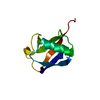[English] 日本語
 Yorodumi
Yorodumi- PDB-8sn6: Cryo-EM structure of the human nucleosome core particle in comple... -
+ Open data
Open data
- Basic information
Basic information
| Entry | Database: PDB / ID: 8sn6 | |||||||||
|---|---|---|---|---|---|---|---|---|---|---|
| Title | Cryo-EM structure of the human nucleosome core particle in complex with RNF168 and UbcH5c~Ub (UbcH5c chemically conjugated to histone H2A) (class 4) | |||||||||
 Components Components |
| |||||||||
 Keywords Keywords | TRANSFERASE/DNA / Nucleosome core particle / chromatin / RNF168 / RING domain / UbcH5c / DNA repair / DNA double-strand break / Homologous recombination / 53BP1 / ubiquitin / STRUCTURAL PROTEIN-DNA-TRANSFERASE complex / TRANSFERASE / TRANSFERASE-DNA complex | |||||||||
| Function / homology |  Function and homology information Function and homology informationhistone H2AK15 ubiquitin ligase activity / histone ubiquitin ligase activity / (E3-independent) E2 ubiquitin-conjugating enzyme / Signaling by BMP / protein K6-linked ubiquitination / isotype switching / double-strand break repair via classical nonhomologous end joining / protein K11-linked ubiquitination / hypothalamus gonadotrophin-releasing hormone neuron development / female meiosis I ...histone H2AK15 ubiquitin ligase activity / histone ubiquitin ligase activity / (E3-independent) E2 ubiquitin-conjugating enzyme / Signaling by BMP / protein K6-linked ubiquitination / isotype switching / double-strand break repair via classical nonhomologous end joining / protein K11-linked ubiquitination / hypothalamus gonadotrophin-releasing hormone neuron development / female meiosis I / positive regulation of protein monoubiquitination / DNA repair-dependent chromatin remodeling / negative regulation of BMP signaling pathway / mitochondrion transport along microtubule / fat pad development / positive regulation of protein targeting to mitochondrion / E2 ubiquitin-conjugating enzyme / K63-linked polyubiquitin modification-dependent protein binding / response to ionizing radiation / female gonad development / seminiferous tubule development / male meiosis I / negative regulation of transcription elongation by RNA polymerase II / protein monoubiquitination / protein localization to CENP-A containing chromatin / positive regulation of intrinsic apoptotic signaling pathway by p53 class mediator / ubiquitin conjugating enzyme activity / protein K63-linked ubiquitination / CENP-A containing nucleosome / negative regulation of tumor necrosis factor-mediated signaling pathway / Replacement of protamines by nucleosomes in the male pronucleus / arachidonate 15-lipoxygenase / arachidonate 15-lipoxygenase activity / positive regulation of DNA repair / nucleosome binding / Packaging Of Telomere Ends / protein K48-linked ubiquitination / protein autoubiquitination / lipoxygenase pathway / Recognition and association of DNA glycosylase with site containing an affected purine / Cleavage of the damaged purine / telomere organization / arachidonate metabolic process / Chromatin modifying enzymes / lipid oxidation / SUMOylation of DNA damage response and repair proteins / interstrand cross-link repair / neuron projection morphogenesis / Deposition of new CENPA-containing nucleosomes at the centromere / regulation of neuron apoptotic process / regulation of proteasomal protein catabolic process / hepoxilin biosynthetic process / ubiquitin ligase complex / Recognition and association of DNA glycosylase with site containing an affected pyrimidine / Cleavage of the damaged pyrimidine / energy homeostasis / linoleic acid metabolic process / Meiotic synapsis / Inhibition of DNA recombination at telomere / Maturation of protein E / Maturation of protein E / ER Quality Control Compartment (ERQC) / nucleosomal DNA binding / Myoclonic epilepsy of Lafora / FLT3 signaling by CBL mutants / Prevention of phagosomal-lysosomal fusion / IRAK2 mediated activation of TAK1 complex / Alpha-protein kinase 1 signaling pathway / Glycogen synthesis / Regulation of TBK1, IKKε (IKBKE)-mediated activation of IRF3, IRF7 / IRAK1 recruits IKK complex / IRAK1 recruits IKK complex upon TLR7/8 or 9 stimulation / Membrane binding and targetting of GAG proteins / Regulation of TBK1, IKKε-mediated activation of IRF3, IRF7 upon TLR3 ligation / Endosomal Sorting Complex Required For Transport (ESCRT) / IRAK2 mediated activation of TAK1 complex upon TLR7/8 or 9 stimulation / PTK6 Regulates RTKs and Their Effectors AKT1 and DOK1 / Negative regulation of FLT3 / Constitutive Signaling by NOTCH1 HD Domain Mutants / Regulation of FZD by ubiquitination / TICAM1,TRAF6-dependent induction of TAK1 complex / RNA Polymerase I Promoter Opening / TICAM1-dependent activation of IRF3/IRF7 / NOTCH2 Activation and Transmission of Signal to the Nucleus / APC/C:Cdc20 mediated degradation of Cyclin B / Assembly of the ORC complex at the origin of replication / p75NTR recruits signalling complexes / Downregulation of ERBB4 signaling / NOTCH3 Activation and Transmission of Signal to the Nucleus / APC-Cdc20 mediated degradation of Nek2A / TRAF6-mediated induction of TAK1 complex within TLR4 complex / TRAF6 mediated IRF7 activation in TLR7/8 or 9 signaling / PINK1-PRKN Mediated Mitophagy / Pexophagy / Regulation of innate immune responses to cytosolic DNA / InlA-mediated entry of Listeria monocytogenes into host cells / VLDLR internalisation and degradation / Regulation of pyruvate metabolism / Downregulation of ERBB2:ERBB3 signaling / Interleukin-7 signaling Similarity search - Function | |||||||||
| Biological species |  Homo sapiens (human) Homo sapiens (human) | |||||||||
| Method | ELECTRON MICROSCOPY / single particle reconstruction / cryo EM / Resolution: 3.7 Å | |||||||||
 Authors Authors | Hu, Q. / Botuyan, M.V. / Zhao, D. / Cui, G. / Mer, G. | |||||||||
| Funding support |  United States, 2items United States, 2items
| |||||||||
 Citation Citation |  Journal: Mol Cell / Year: 2024 Journal: Mol Cell / Year: 2024Title: Mechanisms of RNF168 nucleosome recognition and ubiquitylation. Authors: Qi Hu / Debiao Zhao / Gaofeng Cui / Janarjan Bhandari / James R Thompson / Maria Victoria Botuyan / Georges Mer /  Abstract: RNF168 plays a central role in the DNA damage response (DDR) by ubiquitylating histone H2A at K13 and K15. These modifications direct BRCA1-BARD1 and 53BP1 foci formation in chromatin, essential for ...RNF168 plays a central role in the DNA damage response (DDR) by ubiquitylating histone H2A at K13 and K15. These modifications direct BRCA1-BARD1 and 53BP1 foci formation in chromatin, essential for cell-cycle-dependent DNA double-strand break (DSB) repair pathway selection. The mechanism by which RNF168 catalyzes the targeted accumulation of H2A ubiquitin conjugates to form repair foci around DSBs remains unclear. Here, using cryoelectron microscopy (cryo-EM), nuclear magnetic resonance (NMR) spectroscopy, and functional assays, we provide a molecular description of the reaction cycle and dynamics of RNF168 as it modifies the nucleosome and recognizes its ubiquitylation products. We demonstrate an interaction of a canonical ubiquitin-binding domain within full-length RNF168, which not only engages ubiquitin but also the nucleosome surface, clarifying how such site-specific ubiquitin recognition propels a signal amplification loop. Beyond offering mechanistic insights into a key DDR protein, our study aids in understanding site specificity in both generating and interpreting chromatin ubiquitylation. | |||||||||
| History |
|
- Structure visualization
Structure visualization
| Structure viewer | Molecule:  Molmil Molmil Jmol/JSmol Jmol/JSmol |
|---|
- Downloads & links
Downloads & links
- Download
Download
| PDBx/mmCIF format |  8sn6.cif.gz 8sn6.cif.gz | 344.1 KB | Display |  PDBx/mmCIF format PDBx/mmCIF format |
|---|---|---|---|---|
| PDB format |  pdb8sn6.ent.gz pdb8sn6.ent.gz | 261.5 KB | Display |  PDB format PDB format |
| PDBx/mmJSON format |  8sn6.json.gz 8sn6.json.gz | Tree view |  PDBx/mmJSON format PDBx/mmJSON format | |
| Others |  Other downloads Other downloads |
-Validation report
| Summary document |  8sn6_validation.pdf.gz 8sn6_validation.pdf.gz | 1.3 MB | Display |  wwPDB validaton report wwPDB validaton report |
|---|---|---|---|---|
| Full document |  8sn6_full_validation.pdf.gz 8sn6_full_validation.pdf.gz | 1.3 MB | Display | |
| Data in XML |  8sn6_validation.xml.gz 8sn6_validation.xml.gz | 42.1 KB | Display | |
| Data in CIF |  8sn6_validation.cif.gz 8sn6_validation.cif.gz | 66.2 KB | Display | |
| Arichive directory |  https://data.pdbj.org/pub/pdb/validation_reports/sn/8sn6 https://data.pdbj.org/pub/pdb/validation_reports/sn/8sn6 ftp://data.pdbj.org/pub/pdb/validation_reports/sn/8sn6 ftp://data.pdbj.org/pub/pdb/validation_reports/sn/8sn6 | HTTPS FTP |
-Related structure data
| Related structure data |  40614MC  8smwC  8smxC  8smyC  8smzC  8sn0C  8sn1C  8sn2C 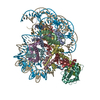 8sn3C  8sn4C  8sn5C  8sn7C  8sn8C  8sn9C 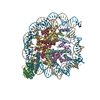 8snaC 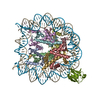 8txvC 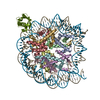 8txwC 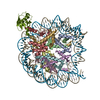 8txxC 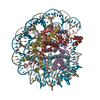 8u13C  8u14C  8upfC 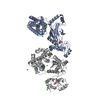 8uq8C 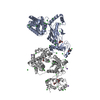 8uq9C 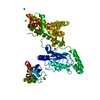 8uqaC 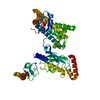 8uqbC 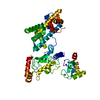 8uqcC 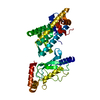 8uqdC  8uqeC M: map data used to model this data C: citing same article ( |
|---|---|
| Similar structure data | Similarity search - Function & homology  F&H Search F&H Search |
- Links
Links
- Assembly
Assembly
| Deposited unit | 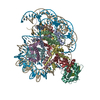
|
|---|---|
| 1 |
|
- Components
Components
-Protein , 7 types, 11 molecules AEBFCGDHKLM
| #1: Protein | Mass: 15786.534 Da / Num. of mol.: 2 Source method: isolated from a genetically manipulated source Source: (gene. exp.)  Homo sapiens (human) Homo sapiens (human)Gene: H3C1, H3FA, HIST1H3A, H3C2, H3FL, HIST1H3B, H3C3, H3FC HIST1H3C, H3C4, H3FB, HIST1H3D, H3C6, H3FD, HIST1H3E, H3C7, H3FI, HIST1H3F, H3C8, H3FH, HIST1H3G, H3C10, H3FK, HIST1H3H, H3C11, H3FF, ...Gene: H3C1, H3FA, HIST1H3A, H3C2, H3FL, HIST1H3B, H3C3, H3FC HIST1H3C, H3C4, H3FB, HIST1H3D, H3C6, H3FD, HIST1H3E, H3C7, H3FI, HIST1H3F, H3C8, H3FH, HIST1H3G, H3C10, H3FK, HIST1H3H, H3C11, H3FF, HIST1H3I, H3C12, H3FJ, HIST1H3J Plasmid: pHISPP / Production host:  #2: Protein | Mass: 11743.792 Da / Num. of mol.: 2 Source method: isolated from a genetically manipulated source Source: (gene. exp.)  Homo sapiens (human) Homo sapiens (human)Gene: H4C1, H4/A, H4FA, HIST1H4A, H4C2, H4/I, H4FI, HIST1H4B, H4C3, H4/G, H4FG, HIST1H4C, H4C4, H4/B, H4FB, HIST1H4D, H4C5, H4/J, H4FJ, HIST1H4E, H4C6, H4/C, H4FC, HIST1H4F, H4C8, H4/H, H4FH, ...Gene: H4C1, H4/A, H4FA, HIST1H4A, H4C2, H4/I, H4FI, HIST1H4B, H4C3, H4/G, H4FG, HIST1H4C, H4C4, H4/B, H4FB, HIST1H4D, H4C5, H4/J, H4FJ, HIST1H4E, H4C6, H4/C, H4FC, HIST1H4F, H4C8, H4/H, H4FH, HIST1H4H, H4C9, H4/M, H4FM, HIST1H4I, H4C11, H4/E, H4FE, HIST1H4J, H4C12, H4/D, H4FD, HIST1H4K, H4C13, H4/K, H4FK, HIST1H4L, H4C14, H4/N, H4F2, H4FN, HIST2H4, HIST2H4A, H4C15, H4/O, H4FO, HIST2H4B, H4-16, HIST4H4 Plasmid: pHISPP / Production host:  #3: Protein | Mass: 13008.156 Da / Num. of mol.: 2 / Mutation: R11S, K15C Source method: isolated from a genetically manipulated source Source: (gene. exp.)  Homo sapiens (human) / Gene: H2AC4, H2AFM, HIST1H2AB, H2AC8, H2AFA, HIST1H2AE / Production host: Homo sapiens (human) / Gene: H2AC4, H2AFM, HIST1H2AB, H2AC8, H2AFA, HIST1H2AE / Production host:  #4: Protein | Mass: 14084.348 Da / Num. of mol.: 2 Source method: isolated from a genetically manipulated source Source: (gene. exp.)  Homo sapiens (human) / Gene: H2BC11, H2BFR, HIST1H2BJ / Plasmid: pHISPP / Production host: Homo sapiens (human) / Gene: H2BC11, H2BFR, HIST1H2BJ / Plasmid: pHISPP / Production host:  #7: Protein | | Mass: 11903.969 Da / Num. of mol.: 1 Source method: isolated from a genetically manipulated source Source: (gene. exp.)  Homo sapiens (human) / Gene: RNF168 / Production host: Homo sapiens (human) / Gene: RNF168 / Production host:  References: UniProt: Q8IYW5, RING-type E3 ubiquitin transferase #8: Protein | | Mass: 17061.418 Da / Num. of mol.: 1 / Mutation: C21I, C107A, C111D, L119K Source method: isolated from a genetically manipulated source Source: (gene. exp.)  Homo sapiens (human) / Gene: UBE2D3, UBC5C, UBCH5C / Production host: Homo sapiens (human) / Gene: UBE2D3, UBC5C, UBCH5C / Production host:  References: UniProt: P61077, E2 ubiquitin-conjugating enzyme, (E3-independent) E2 ubiquitin-conjugating enzyme #9: Protein | | Mass: 9057.391 Da / Num. of mol.: 1 Source method: isolated from a genetically manipulated source Source: (gene. exp.)  Homo sapiens (human) / Gene: UBB / Plasmid: pHISPP / Production host: Homo sapiens (human) / Gene: UBB / Plasmid: pHISPP / Production host:  |
|---|
-DNA chain , 2 types, 2 molecules IJ
| #5: DNA chain | Mass: 45138.770 Da / Num. of mol.: 1 / Source method: obtained synthetically / Source: (synth.)  Homo sapiens (human) Homo sapiens (human) |
|---|---|
| #6: DNA chain | Mass: 45610.043 Da / Num. of mol.: 1 Source method: isolated from a genetically manipulated source Source: (gene. exp.)  Homo sapiens (human) / Production host: Homo sapiens (human) / Production host:  |
-Non-polymers , 1 types, 2 molecules 
| #10: Chemical |
|---|
-Details
| Has ligand of interest | Y |
|---|
-Experimental details
-Experiment
| Experiment | Method: ELECTRON MICROSCOPY |
|---|---|
| EM experiment | Aggregation state: PARTICLE / 3D reconstruction method: single particle reconstruction |
- Sample preparation
Sample preparation
| Component | Name: Human nucleosome core particle in complex with RNF168 and UbcH5c~Ub Type: COMPLEX / Entity ID: #1-#9 / Source: MULTIPLE SOURCES |
|---|---|
| Molecular weight | Value: 0.2565 MDa / Experimental value: NO |
| Source (natural) | Organism:  Homo sapiens (human) Homo sapiens (human) |
| Source (recombinant) | Organism:  |
| Buffer solution | pH: 7.5 |
| Specimen | Conc.: 0.4 mg/ml / Embedding applied: NO / Shadowing applied: NO / Staining applied: NO / Vitrification applied: YES / Details: 10 mM HEPES, 100 mM NaCl, 1 mM DTT, pH 7.5 |
| Specimen support | Grid material: COPPER / Grid type: Quantifoil R1.2/1.3 |
| Vitrification | Instrument: FEI VITROBOT MARK IV / Cryogen name: ETHANE / Humidity: 100 % / Chamber temperature: 277 K |
- Electron microscopy imaging
Electron microscopy imaging
| Experimental equipment |  Model: Titan Krios / Image courtesy: FEI Company |
|---|---|
| Microscopy | Model: FEI TITAN KRIOS |
| Electron gun | Electron source:  FIELD EMISSION GUN / Accelerating voltage: 300 kV / Illumination mode: FLOOD BEAM FIELD EMISSION GUN / Accelerating voltage: 300 kV / Illumination mode: FLOOD BEAM |
| Electron lens | Mode: BRIGHT FIELD / Nominal magnification: 130000 X / Nominal defocus max: 3000 nm / Nominal defocus min: 500 nm / Cs: 2.7 mm |
| Specimen holder | Cryogen: NITROGEN / Specimen holder model: FEI TITAN KRIOS AUTOGRID HOLDER |
| Image recording | Electron dose: 60 e/Å2 / Film or detector model: GATAN K3 BIOQUANTUM (6k x 4k) / Num. of grids imaged: 1 / Num. of real images: 14179 Details: 14179 images were recorded in movie-mode of which 14113 were retained for particle picking. |
- Processing
Processing
| EM software |
| ||||||||||||||||||||||||||||||||||||||||
|---|---|---|---|---|---|---|---|---|---|---|---|---|---|---|---|---|---|---|---|---|---|---|---|---|---|---|---|---|---|---|---|---|---|---|---|---|---|---|---|---|---|
| CTF correction | Type: PHASE FLIPPING AND AMPLITUDE CORRECTION | ||||||||||||||||||||||||||||||||||||||||
| Particle selection | Num. of particles selected: 16063830 | ||||||||||||||||||||||||||||||||||||||||
| Symmetry | Point symmetry: C1 (asymmetric) | ||||||||||||||||||||||||||||||||||||||||
| 3D reconstruction | Resolution: 3.7 Å / Resolution method: FSC 0.143 CUT-OFF / Num. of particles: 33609 / Algorithm: FOURIER SPACE / Symmetry type: POINT | ||||||||||||||||||||||||||||||||||||||||
| Atomic model building | Protocol: RIGID BODY FIT / Space: REAL | ||||||||||||||||||||||||||||||||||||||||
| Atomic model building |
|
 Movie
Movie Controller
Controller






















 PDBj
PDBj

























































